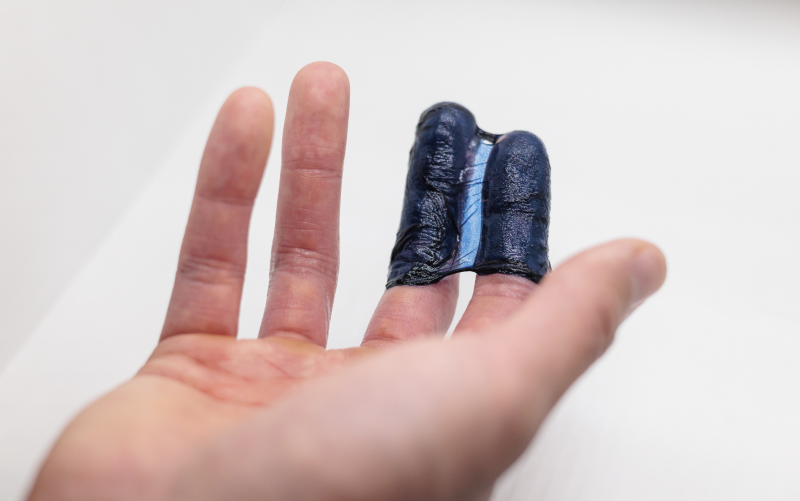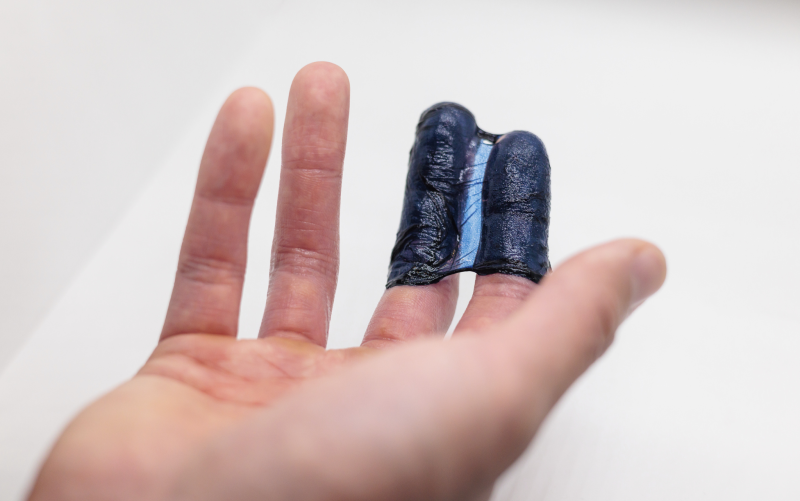Flexible Semiconductor Made from Hydrogel
A bioelectronic interface forms a connection between living tissue and implantable devices such as glucose monitors for diabetics and pacemakers for heart patients. One of the main challenges in making such interfaces is finding materials that can provide accurate data collection, while being well suited to the soft, watery environment within the body. Previously, scientists have tried building these interfaces with semiconducting polymers, but these electronic materials are usually too rigid. Softer options exist, such as certain plastics and gels, but they often lack the electrical performance of semiconductors. Now Sihong Wang of the University of Chicago and his collaborators have developed a hydrogel semiconductor that provides the desired electronic properties in a biocompatible material [1].
Hydrogels are polymer materials made by linking together water-loving polymers, such as cellulose and polyacrylic acid. In water, this linked network swells up, with H2O molecules filling in the spaces between the polymer fibers. Hydrogels find widespread use in bioengineering owing to their flexibility and their permeability to oxygen and other chemical nutrients. However, their water-rich contents pose a barrier to the fabrication of semiconducting hydrogels. “Almost all semiconducting polymers are insoluble in water,” Wang says, meaning that they don’t easily integrate within the hydrogel. Wang and colleagues solved this quagmire by decoupling the crosslinking and the water-swelling steps in the preparation of the hydrogel.
Rather than using water as their base liquid, the researchers started with an organic solvent, into which they dissolved semiconductor polymers with hydrophilic side chains along with hydrogel ingredients (hydrogel monomers and crosslinkers that initiate hydrogelation). On exposure to ultraviolet light, the hydrogel ingredients assembled into an interconnected network, forming a gel, while the semiconductor polymers became trapped in the hydrogel network. When a sheet of this gel was dipped in water, water rushed in and forced the organic solvent out. Following the solvent swap, the gel turned into a highly stretchable and bluish hydrogel with the consistency of gelatin. The semiconducting polymers, insoluble in water, quickly precipitated and assembled into a percolated network within the hydrogel matrix. The resulting material was a semiconductor, but one that retained the flexibility of traditional hydrogels.
The high interconnectivity of the semiconducting clusters in the new material explains how electrical charges can move easily across it. The clusters exhibited order over short distances, but they did not form a rigid, long-range structure as they typically do with normal fabrication processes. The researchers suggest that this lack of long-range order is a consequence of the quick precipitation and resistance from the hydrogel network already in place.
The researchers measured the charge carrier mobility through the hydrogel and found a value of 1.4 cm2 V−1 s−1, which is low compared to common solid-state semiconductors that have mobilities of around 1000 cm2 V−1 s−1. “[Although] it’s not as high performance as silicon, it is still sufficient for many biointerfaced applications,” says Wang. Indeed, the hydrogel semiconductor has an electronic performance that is comparable to other polymer semiconductors, but the hydrogel’s softness is closer to that of living tissues. The hydrogel is also porous, which can facilitate modifications to its chemistry for particular applications.
The researchers tested the biocompatibility of their new material by placing hydrogel semiconductor implants in mice and monitoring the immune response over a four-week period. One of the major concerns with implantable devices is the foreign-body response in which the immune system tries to isolate the implant behind a collagen wall. Wang and colleagues measured the collagen density around their implants and used that to assess biocompatibility. They found that implants of hydrogel semiconductor induced a lower immune response than other implants made of pure hydrogel or pure polymer semiconductor.
The team also evaluated the hydrogel semiconductor’s biosensitivity, which is a measure of how well biomolecules can move through a material. The biosensitivity of regular semiconductors (including polymer semiconductors) are limited by their high density, which impedes the movement of molecules into the interior where they might be detected for sensing applications. Wang and colleagues found that their hydrogel semiconductor performed better than polymer semiconductors, allowing biomolecules as large as proteins and nucleic acids to efficiently penetrate into the inner volume.
Ximin He, a biomaterials researcher at UCLA who was not involved in the study, is impressed by the new approach’s capability of producing hydrogels with both low stiffness and good conductivity. This combination is particularly challenging to achieve, she says, since making the gel softer typically disrupts the molecular ordering necessary for good electrical performance. With further development, she imagines that soft-material-based bioelectronics could be made for a variety of applications.
The hydrogel semiconductor has shown promise, but more work will be needed before clinical testing, Wang says. One challenge is to prepare the hydrogel semiconductor in miniaturized packets that would fit into sensor arrays and other devices. Wang adds that a further assessment of stability is needed to see whether the hydrogel performance changes over time when implanted in the human body.
–Sachin Rawat
Sachin Rawat is a freelance science writer based in Bangalore, India.
References
- Y. Dai et al., “Soft hydrogel semiconductors with augmented biointeractive functions,” Science 386, 431 (2024).





